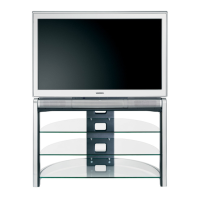
Do you have a question about the Toshiba 36ZP46 Series and is the answer not in the manual?
| Composite Video Inputs | 2 |
|---|---|
| Number of Speakers | 2 |
| Screen Size | 36 inches |
| Inputs | Component Video, Composite, S-Video, RF |
| Sound Output | 20W (10W x 2) |
Guidelines for proper ventilation and avoiding heat damage to the television.
Instructions for safe connection to the power supply and handling electrical components.
Essential safety practices and warnings to prevent hazards during use.
Advice on placing the TV for optimal viewing and safety, avoiding direct sunlight and unstable surfaces.
Instructions for screen cleaning and responsible disposal of the television at its end of life.
Toshiba's liability limitations and recommendations for preventing screen burn-in.
Overview of buttons and their operations for TV and external devices.
Guidance on inserting batteries and understanding the remote's effective operating range.
Preferred methods for connecting aerials, decoders, and VCRs using SCART leads.
Details on connecting various devices via SCART, Component Video, and Digital Audio inputs.
Specific considerations when using component video inputs, affecting certain TV functions.
Guidelines for positioning and connecting surround and front extension speakers for optimal audio.
Instructions on connecting an external amplifier to the TV's surround sound outputs.
How to turn the television on, put it into standby, and resume normal viewing.
Using remote control buttons to access and operate the television's menus and settings.
Information about the headphone socket and its effect on speaker sound output.
How to choose the preferred language for on-screen menus and text.
Step-by-step guide to automatically scan and store available television channels.
Steps to enter the manual tuning menu for channel setup.
Manually assigning channels to programme positions and searching for signals.
Finalizing manual tuning, storing channels, and direct channel entry.
How to skip specific programme positions to prevent them from being viewed.
Rearranging channel order and selecting desired programme positions.
Controlling volume, mute, super woofer, bass, treble, and balance.
Introduction to Super Live, Cinema, and Subtitle modes for adjusting picture aspect ratio.
Applying 14:9, Wide, and 4:3 formats for different broadcast types.
Customizing picture styles with preset modes or storing personal settings.
Enabling DNR to soften screen representation and reduce noise on weak signals.
Enhancing dark areas of the picture for improved definition.
Choosing between NATURAL, ACTIVE, 100Hz, and PROGRESS. scan modes.
Adjusting the 'warmth' or 'coolness' of the picture by altering red or blue tint.
Modifying picture position and size for external inputs or personal preference.
Correcting picture tilt caused by the Earth's magnetic field on specific models.
Holding a static image and activating the blue screen feature for no signal.
Enabling automatic display adjustment for widescreen broadcasts.
Programming the TV to turn on or off automatically at specific times.
Disabling front panel buttons to prevent accidental changes.
Showing the time and selecting stereo or bilingual audio for broadcasts.
Manually choosing input signals when automatic switching fails.
Setting up digital audio inputs (DA-1, DA-2) for permanent equipment connections.
Specifying signal types (AV, S-VIDEO) for SCART inputs.
Selecting the source signal to be output through SCART 3.
Adjusting delay time to synchronize rear speaker audio with front speaker audio.
Fine-tuning speaker levels and testing audio output for Dolby Digital.
Testing individual speaker output for Dolby Pro Logic surround sound.
Selecting various surround sound effects like Hall, Theatre, Disco, Stadium, Pseudo surround.
Choosing the character set and viewing mode (AUTO or LIST) for teletext.
Accessing pages using Auto mode with coloured buttons or List mode for favourite pages.
Using buttons to display the index, specific pages, and news flashes.
Managing sub-pages, concealed text, holding pages, and enlarging text display.
Selecting pages while viewing normal TV and cancelling teletext.
Details on supported broadcast systems (PAL, SECAM) and video input formats.
List and description of all external connection sockets like SCART, Component, and Digital Audio.
Technical details including programme positions, screen size, sound output, power consumption, and dimensions.
List of included accessories such as the remote control and batteries.